chicagosilver
Posts: 227
Registered: Aug 2005
|
 posted 04-03-2014 01:48 PM
posted 04-03-2014 01:48 PM
  
[17-0516] 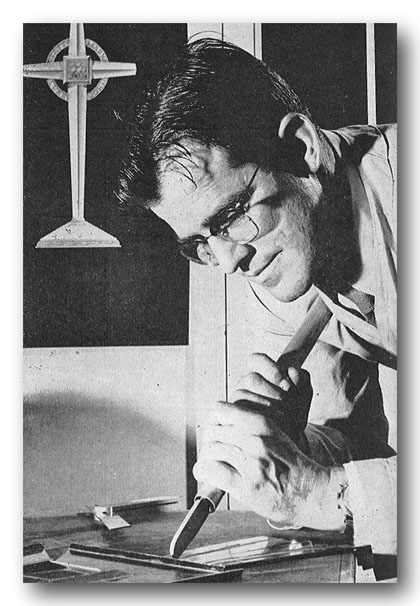
Ask most people to name a top California silversmith and they'll mention Blanchard, Friedell, maybe Bellis, Adler, and Shreve. One under-appreciated superstar, Hudson Roysher, should be on that list. This omission may be because he spent a lot of his life teaching, and produced mostly ecclesiastical objects. But his skill and output rival the others above. A Cleveland native, Roysher was born in 1911 to a craft-oriented family, and studied metalsmithing at the Cleveland Art Institute. Even before graduation he exhibited his silver at the Cleveland Museum of Art's vaunted May Show. In later years his work won several May Show first prizes. He began teaching at the University of Southern California in the late 1930s, and went on to teach at the Chouinard Art Institute, UCLA, and finally Los Angeles State College (later renamed California State University), where he headed the Art Department. Prior to 1951 his work was almost entirely non-religious, and was sold at Gump's in San Francisco. But that year he began focusing on ecclesiastical silver. "I'd always wanted to do this type of work," he told one reporter. "Research showed me there was much more scope in using techniques—and a richness in design not possible in making secular silver…I made a processional cross of rosewood and silver—for no other reason than that I wanted to make it. I exhibited it and it won an award at the Cleveland Art Institute. Then I put it away. One day a friend saw the cross and fell in love with it." "I work with tool steel, on highly polished stakes which I make myself. Working with students, we sometimes buy German pattern hammers and re-grind the faces. Ecclesiastical silver is a quality product throughout. Only solid silver molding is used. Chrome rouge is employed for finishing," he said in a 1957 article, adding "I have always been tremendously interested in experimenting with the combination of unusual materials; combining silver with ivory, ivory and cane, silver and rare wood. This has carried through to my religious work." "I do use a great many early religious symbols, but I always try for a different artistic approach. I have no qualms whatsoever about doing good period pieces. I think one can look to good art of the past in any field and receive inspiration from it. I can find wonderful inspiration for contemporary design in early armor. I'll go out of my way, to see a good armor exhibit…There are great lesson-teaching qualities in studying armor, too. It had to be functional—or somebody died!" "…I love mechanics! I believe fundamentally in fine workmanship. I believe also that, in some of the things we see today, craftsmanship has fallen by the wayside. One can't be half-trained in metal work, then put his emotions into it." Roysher died in 1993. In a 1967 interview, he provided two of my favorite silver quotes: "Looking at a piece of silver is like looking into a pool of clear water. There is a depth to it that other metals do not have." and "I ask myself: 'Will this thing last for at least 100 years?' My work has to be of the best quality that I am capable of at the time." Roysher's work does appear from time to time, although since much of it resides in churches it will probably stay off the market. His mark is a conjoined HR. The ladle shown here is a simple piece, but beautifully made. The bespoke storage pouch is a nice touch too.
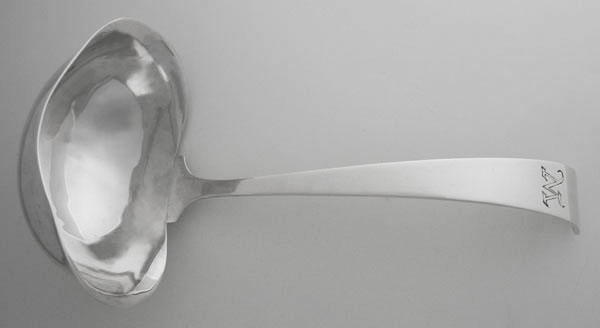
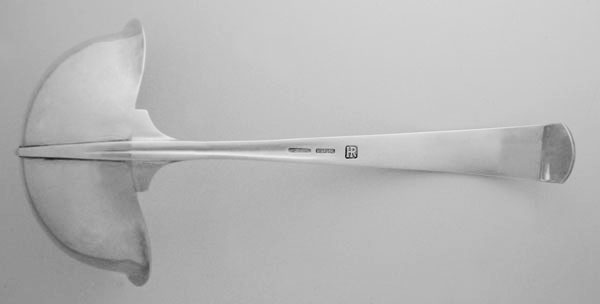
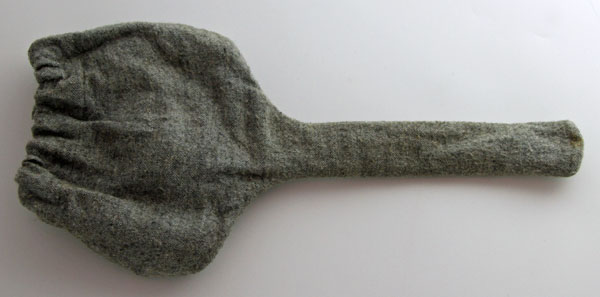
 IP: Logged |
Scott Martin
Forum Master Posts: 11520
Registered: Apr 93
|
 posted 04-05-2014 10:26 AM
posted 04-05-2014 10:26 AM
  
quote:
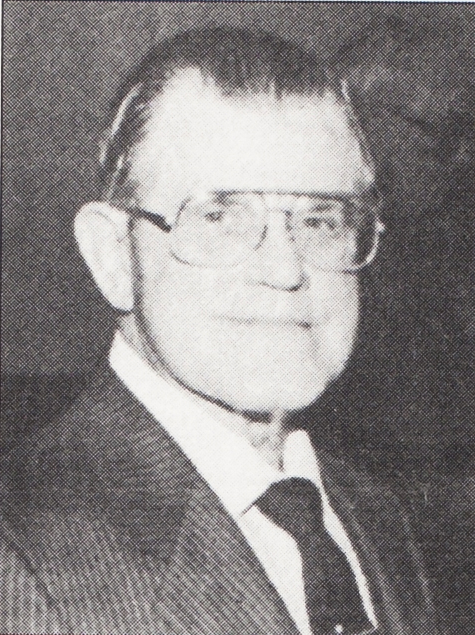
[<gone from the internet> web.calstatela.edu/univ/emeriti/inmemoriam.htm#339]
HUDSON ROYSHER[/i] (1954-1975, Art) died on June 23, 1993 in La Jolla, CA after a long illness. A graduate of Western Reserve University (later Case Western Reserve University) (A.B., 1934) and USC (M.F.A., 1938), he was a distinguished member of the Cal State L.A. faculty for 21 years, the last five of which he spent as department chair. "Hud," as he was known by close colleagues and friends, excelled in many areas of education and was one of the campus' earliest recipients of the Outstanding Professor Award (OPA)–in the 1963-64 academic year. He went on to receive the CSU system wide OPA in 1965-66. Besides being an excellent and popular teacher, he was a scholar, an avid champion of academic freedom, and one of the country's outstanding silversmiths. At CSLA, he was active in academic governance. He served a number of years on the Academic Senate and on many campus committees as well, among them the Committee on Committees and the Academic Freedom and Professional Ethics Committee. He also was a member of the local chapters of the American Association of University Professors (AAUP) and the Association of California State College (now University) Professors (ACSUP), of which he was president in 1963-64. In addition, he was an important member of the CSU Year-Round Conversion Study Committee and drafted an amendment to Title V to protect the academic year. Born into a family of artists (sculptors), he had a clear vision of his career interests from an early age. He began as an industrial designer but became interested in ecclesiastical iron-work. His interest led him to specialize in this field, and his work earned him a worldwide reputation for magnificent designs of church altar pieces: crosses, candelabra, chalices, tabernacles and even altars. His commissioned works are found in churches and museums throughout the world, including the Smithsonian Institution. Locally, St. Peter's Episcopal Church (San Pedro), All Saints Episcopal Church (Beverly Hills), St. Brigid's Roman Catholic Church (Los Angeles), St. Catherine's Military School Chapel (Anaheim), La Casa de Maria Retreat Chapel (Montecito), and St. Paul's-in-the-Desert Episcopal Church (Palm Springs) exhibit his works. This work in turn led him to create another form of ceremonial art—university maces. One of the most visible signs of his artwork at CSLA is the University Mace, which was first carried in the 1960 Commencement Exercises and has been included each year since then. (The honor of carrying the mace is accorded the Chair of the Academic Senate.) Besides Cal State L.A., he created maces for USC, the University of Buffalo, Syracuse University, and Bethune-Cookman College. Roysher was one of five silversmiths whose works were selected by the U.S. State Department for a two-year European tour in 1951-53. He was honored on campus with an exhibition of his silver work in February 1967. Emerita Librarian Mary Gormly, who recalls the exhibit, described his works as "breathtaking... particularly the small pieces of jewelry." A life fellow of the International Institute of Arts and Letters, Roysher was profiled in design, art, and architecture publications both in the U.S. and abroad, including Amerika, the Russian language publication issued by the U.S. Information Agency. He left his mark as a craftsman at CSLA and other campuses as well. He was responsible for organizing the Department of Industrial Design at the University of Illinois (1937-38), Chouinard Art Institute (1945-50), and UCLA (1953-54). He also taught industrial design in the College of Architecture and Fine Arts at USC (1939-42). In retirement, he kept busy with his craft, completing a six-foot brass and red leather processional cross in 1985 to complete the sanctuary appointments he made 31 years earlier for St. Peter's Episcopal Church. The Emeriti Association featured him as its first Emeriti Lecturer in 1986. He spoke about his work and illustrated his lecture with impressive color slides. Some years ago he was honored by Syracuse University which established a Hudson Roysher Manuscript Center to house his working sketches, drawings, correspondence, notes, exhibition catalogs, and related items. All of this is for the "enlightenment of future scholars"—an honor that delighted the talented professor. In his memory, CSLA's John F. Kennedy Library has established the Hudson Roysher Memorial Fund. Roysher was a strong supporter of the Library and its librarians and a close friend of the late Vice President for Academic Affairs, John A. Palmer. It is perhaps no coincidence that the Library's collection of art books is housed in the John A. Palmer Wing. It was a fitting tribute that at Hudson Roysher's memorial service (at St. Peter's in San Pedro) on July 17, the Cal State L.A. mace that he lovingly crafted many years ago was carried by Academic Senate chair Edward M. Goldberg. The processional cross he completed for St. Peter's in 1985 was carried at the service, also. Roysher is survived by his wife Allie, a CSLA graduate in art (ceramics); a son, Martin, of Albany; a daughter, Allison, of St. Louis; and two grandchildren.
The Emeritimes, Fall 1993
quote:
 Description Mid-20th century, marked ''HR'' and ''Sterling'', each with an incised circular band supporting six tapering candlesticks with deep drip pans and urn-form bobeches, centered by a cylindrical stem with central candlenozzle, interspersed with crenellated bands, with inscription to central band, over circular bases, on square feet, 73'' H x 22'' Dia., est:$8000/10,000. Literature: For further reading on Hudson Roysher see Silver Magazine, May/June 2006, volume 38, number 3, pp. 14-18. Note: Hudson Brisbine Roysher's modern silver designs exemplify the movement of artists and craftsmen the mid-20th century to break with tradition and experiment with contemporary forms and ideas. Born in Cleveland, Ohio in 1911, Roysher began a career in industrial design after graduating from Cleveland School of Art and Western Reserve University. He followed up his studies in Cleveland by working as a design instructor and earning an M.B.A. from the University of Southern California. He exhibited works in silver and exotic woods at prestigious design shows like the May Show at the Cleveland Museum of art and the New York gallery of the American Craftsmen's council. Roysher received orders from prominent firms like Gump's, San Francisco as well as private clients such as Margaret Lecky and the Gamble House in Pasadena. By the 1950s his interests moved from secular to ecclesiastical silver due to his spiritual convictions and desire to broaden the scope of his work by incorporating liturgical concepts in his designs. This and the following lot are from Roysher's most famous church commissions, in Beverly Hills, California. The church's Gothic style inspired the dramatic, attenuated forms and crenellated decoration of the pieces he produced. In 1971, he was appointed as chairman of the art department at Los Angeles State College and subsequently declined further commissions to focus on his academic responsibilities. Roysher died in Los Angeles in 1998.
IP: Logged |

 SMP Silver Salon Forums
SMP Silver Salon Forums

 20th/21st Century Silversmiths
20th/21st Century Silversmiths

 Hudson Roysher
Hudson Roysher







